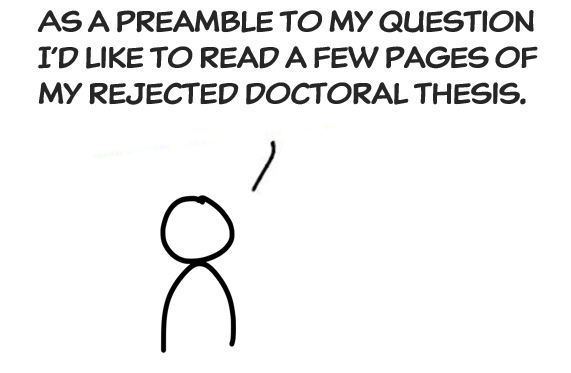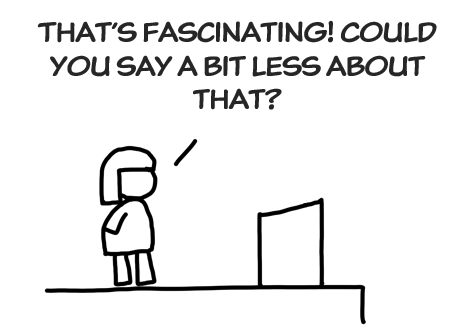Q&A: 7 Common Problems
And how to handle them
Sometimes, the Q&A will throw you a curveball: language issues, long-winded questions, or people making false claims. Here’s how to handle these and other issues.
1. Monologues
Problem: Instead of asking a question, someone tries to deliver a speech of their own, hogging the microphone way beyond what’s reasonable.
Solution: The rest of the audience wants you to stop this person, but crucially, without humiliating them. To do so, don’t wait for a natural break in the person’s speech flow. You simply have to start speaking over them. Say:
In most cases, this will make the person get to the point so you can give an answer.1
Once in a rare while, the person will continue to monologue even after your prompt. In that case, you need to interrupt them again. Use question hijacking to segue into an answer:
If they try to continue after you’ve replied, say: “Wait, I want to make sure we hear from a few other people as well”, then pick a different person.
2. Language barriers
Problem: You don’t understand the person’s dialect or accent (e.g. if you’re speaking abroad).
Solution: Don’t ask them to repeat the question. You probably won’t get it the second time either. Instead, get help from the audience:
The point of the wording is to make it about you, vs. blaming it on their dialect. And of course, if you suspect language barriers may be an issue at a specific event, enlist a local person ahead of time to help you.
3. Vague questions
Problem: A question is unclear or too vague to allow for a good reply.
Solution: Ask the person to expand:
“Can you say a bit more about that? I’d love to understand a bit more of the context.”
“I’m curious, what made you bring up that question? This sounds like something you have grappled with yourself?”
The ‘say more’ tactic is particularly useful when someone challenges you. Instead of getting defensive, use this to show curiosity towards them.
4. You don’t have an answer
If you don’t know the answer – or if you just want to make things more dynamic – ask the rest of the audience:
“I’m not sure I have a good answer to that. Does anyone have experience with this?”
“I can share my thoughts, but I’m curious: do one of you have a sense of what the answer could be?”
Worst case, if nobody responds, you’ll at least get a few extra seconds of thinking time. Also, note how the scripts deliberately lower the bar for responding (‘have a sense of’, not ‘know’).
5. Off-topic questions
If the question is off-topic, simply defer it by referring to the group’s needs:
“Can we potentially chat after the session? I don’t think I can do your question justice with a short reply, and the longer reply might not be relevant for the full group.”
“Would you mind if we take that one by email instead? I’m a little mindful that this might not be relevant to everyone.”
If in doubt, you can survey the room: ask people to raise their hand if this is something that’s relevant for them.
6. Mistaken beliefs and false claims
Problem: You need to nuance or contradict something that was said (e.g. a false claim).
Solution: There’s a formula here that works wonders:
The formula acknowledges their initial belief as reasonable – helping them save face – but also tells the story of how you came to learn otherwise. As an example, imagine someone says “It’s simply not possible to innovate in a big company!” The reply:
Use this only if their belief is in fact reasonable. If it’s more extreme (“The earth is flat!”), you can contradict them more directly. (“The earth is round. And we know this because…”)
7. Awkward silence
Problem: Nobody has any questions for you.
Solution: This happens, and importantly, it does not mean people didn’t like the talk. So just say:
The room will then fill with the pleasant buzz of people talking to each other. After a few minutes of this, do one of two things:
If you want interaction, pick someone and ask, “What came up in your group?” You can then respond to that, or simply say ‘Great point’ and sample a few more groups.
As an alternative, just end the talk by sharing your closer: “You are welcome to reach out later if you want. Now, to wrap up, let me share a final thing…”
***
A final tip: Many speakers respond to questions by saying “That’s a great question.” I suggest you avoid using that one; it’s a cliché, and it rarely sounds genuine, especially when used more than once. If you want to recognize the person who spoke, explain why it’s a good question - or, barring that, at least vary the words you use (e.g. ‘Good point!’ or ‘You’re raising a critical issue’).
If you haven’t yet, make sure to read How to Hijack a Question and Q&A: The Basics.
The ‘So wait, what’s your question’ prompt is shared by Scott Belsky in his book “Confessions of a Public Speaker”.








